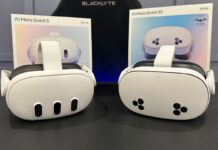
Samsung has returned with another iteration of the Gear VR headset, only this time it includes a Bluetooth controller meant to enhance the experience of viewing content or playing games.
Adding the controller puts the Gear VR more in line with similar VR headsets, like Google’s Daydream View. It also changes the input method because of the remote, meaning that navigating a menu or playing a game is more centralized to the wireless remote’s motion-sensored functions.
Gear VR design
Not surprisingly, Samsung didn’t revamp the design a whole lot from last year’s model. The touchpad on the right side has the same two buttons—home and back—right above, with volume rockers a little further to the front. The dial on top sharpens the focus. A USB-C port on the underside passes through to charge the phone when it’s docked in.
The claspe mechanism on the front is also the same, using a USB-C port to dock the phone. A microUSB adapter comes in the box to accommodate previous Samsung handsets.

Compatibility is still limited to Samsung’s own devices. These include the Galaxy S8, S8+, S7, S7 edge, S6 edge+, S6 and S6 edge. The remote will be made available as a separate purchase because it is backward compatible with the 2016 Gear VR headset too.
The cloth face pad uses Velcro to stay in place, which also makes it washable as a separate piece. Again, this is a carryover from the previous model. So are the straps to hold it in place. Out of the box, the overhead one is kept aside, but it’s easy to install, in case you want the extra support.
Using the headset
The basic premise behind each iterative Gear VR unit is the simplicity in how to use it. Setting it up is no different than before. Plugging the phone in, a screen will pop up that sets the process in motion to download the Oculus Store app and optimize the device for use with the headset. It would have been nice if Samsung hadn’t required removing the phone to finish the job, but it’s also somewhat understandable, given you can only download or purchase content initially while browsing the store.
The difference in setup this time is the remote. Pairing was quick and painless. Interestingly, though, Samsung chose to power it with two AAA batteries (a pair comes in the box), rather than a rechargeable lithium battery. Firmware updates are immediately loaded onto the remote upon setup, keeping everything current.
The remote itself has a trigger button on the back, plus a circular clickable touchpad up front with buttons for back, home and volume below. It’s also angular for a better ergonomic fit in your hand. The motion sensor inside allows it to function like a laser pointer when viewing content through the headset. The trigger could act as an action for any game, be it shooting a gun or opening a door, for example.

The inclusion of the controller is easily the biggest usability difference here. Previously, input controls were centred on the touchpad on the headset itself. There’s no real head tracking, like that of more premium VR headsets like the Oculus Rift, but the Gear VR is really more of an entry-level piece anyway.
That a Facebook login is required to get to the Oculus Store is probably going to be a little divisive. Yes, a lot of people are on the social network, but the attempt to get users to share VR experiences through the headset is going to be interesting to watch.
Content for Gear VR
Samsung had initially announced 70 new Gear VR titles with controller support would be available for the new Gear VR. Currently, there were about 30 in the Oculus Store as of this review, where the rest will reportedly come in the next few months.
The controller-compatible apps and games are nicely laid out in a separate section in the store to make it easier to shop around. Overwhelmingly made up of games, the list isn’t a bad start. You have zombie shooters, space invader-type action and other titles covering different genres. Non-gaming content includes Facebook 360 to view 360-degree videos and photos, Paint VR to bring out the artistic side and Star Chart to explore the solar system.
Most of the games or apps will incur a cost, ranging between $2.00-$10, with previews to at least show what it looks and plays like.
Naturally, all VR content available in the Oculus Store is accessible. If the controller can’t work with it, you have to use the touchpad on the headset itself as a fallback. If you are graduating to this model from a previous version of the Gear VR, past purchases can be downloaded again from your purchasing and download history.
Samsung also makes its own VR app available to view content shot on the Gear 360 camera. YouTube is also there for the same reason, and the bevy of 360-degree video on there should be entertaining. The controller does make it easier to search for something, though the curation isn’t bad at picking out good ones to serve up first.
Final Thoughts
If you already have last year’s Gear VR headset, you are better off buying the remote separately and going from there. You may already get the new one if bundled with the Galaxy S8 or S8+, but either way, this is a good entry point into experiencing VR in a way that is highly accessible.
It would be nice if Samsung opened things up a bit to allow more content sources beyond the Oculus Store, but for now, it does the job. The games and app selection has improved over the last two years, and assuming all goes well this year, the library should look much better moving forward. The Facebook integration will clearly factor in, one way or another.
VR is somewhat of an acquired taste for repeated uses, but it is a crowd-pleaser for just about anyone initially. The Gear VR is an accessible model, even if compatibility is limited to Samsung’s own phones. It doesn’t require much upkeep and can be great fun for shorter spurts when looking at a single screen won’t do.
The Samsung Gear VR is available now.




Nice post. Very good review. Thank you very much for share!
Comments are closed.